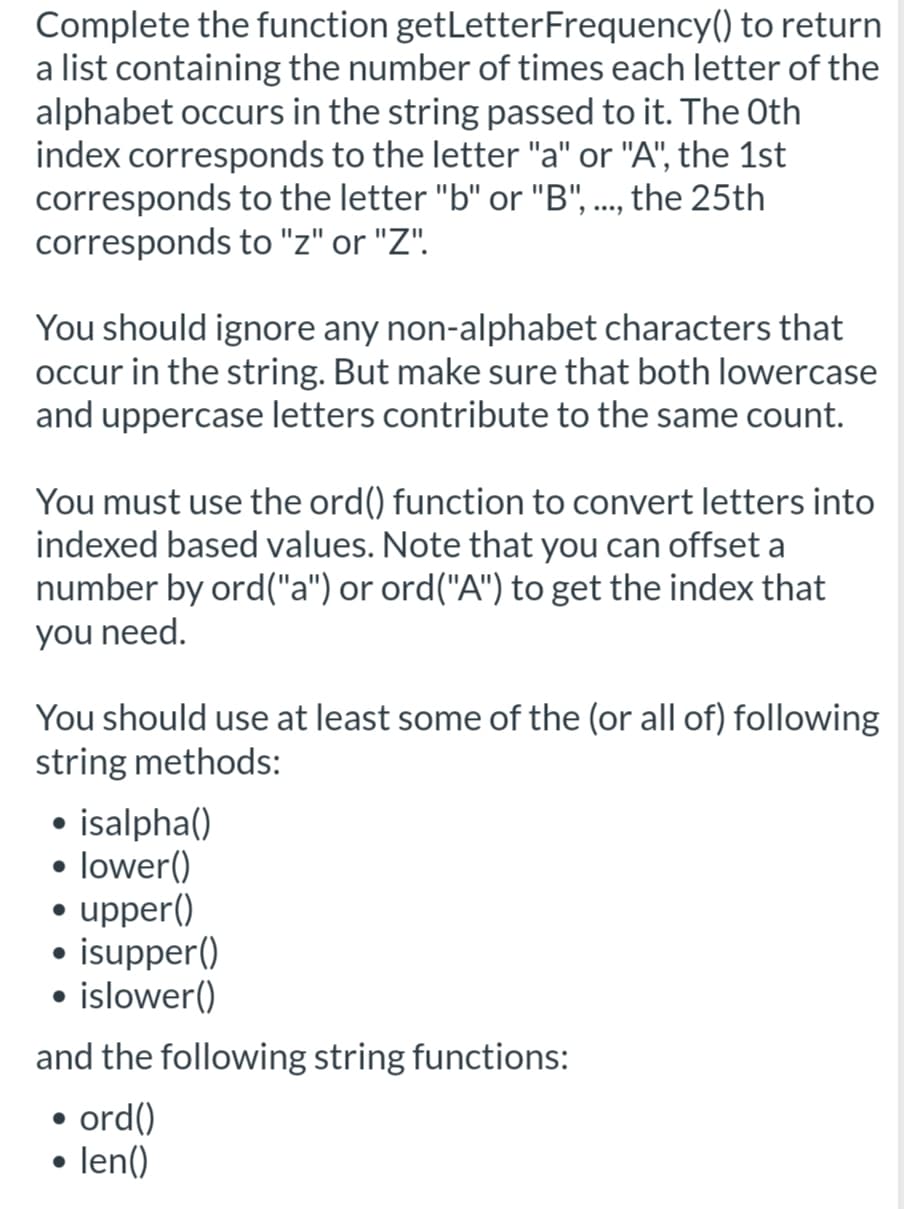Complete the function getLetterFrequency() to return a list containing the number of times each letter of the alphabet occurs in the string passed to it. The Oth index corresponds to the letter "a" or "A", the 1st corresponds to the letter "b" or "B", ..., the 25th corresponds to "z" or "Z".
Complete the function getLetterFrequency() to return a list containing the number of times each letter of the alphabet occurs in the string passed to it. The Oth index corresponds to the letter "a" or "A", the 1st corresponds to the letter "b" or "B", ..., the 25th corresponds to "z" or "Z".
Database System Concepts
7th Edition
ISBN:9780078022159
Author:Abraham Silberschatz Professor, Henry F. Korth, S. Sudarshan
Publisher:Abraham Silberschatz Professor, Henry F. Korth, S. Sudarshan
Chapter1: Introduction
Section: Chapter Questions
Problem 1PE
Related questions
Question
In python
![Count all the letters in a sentence. Both A and a should count for the same letter.
The best way to get an indexed letter value is subtract ord("a") or ord("A") from your
current letter.
String methods: isalpha(), lower(), upper(), islower(), isupper()
String functions: ord(), len()
def getLetterFrequency(sentence):
freq = ]
for i in range(26):
%3D
freq.append(0)
# TODO: count each letter here
return freq
print(getLetterFrequency("Hello World"))
# remove the
when you're ready to rest fully
print("Testing")
assert( getLetterFrequency("Hello World!") == [0, 0, 0, 1, 1, 0, 0, 1, 0, 0, 0, 3, 0, 0, 2, 0,
0, 1, 0, 0, 0, 0, 1, 0, 0, 0])
assert( getLetterFrequency("Wow, such tricky...") == [0, 0, 2, 0, 0, 0, 0, 1, 1, 0, 1, 0, 0, 0,
1, 0, 0, 1, 1, 1, 1, 0, 2, 0, 1, 0])
assert( getLetterFrequency("The quick brown fox jumps over the lazy dog.") == [1, 1, 1,
%3D
%3D
1, 3, 1, 1, 2, 1, 1, 1, 1, 1, 1, 4, 1, 1, 2, 1, 2, 2, 1, 1, 1, 1, 1])
print("Done!")
# remove the
when you're ready to rest fully
Expected Output
Example, the string "Hello World" returns list: [0, 0, 0, 1, 1, 0, 0, 1, 0, 0, 0, 3, 0, 0, 2, 0,
0.100.001.0.0.01](/v2/_next/image?url=https%3A%2F%2Fcontent.bartleby.com%2Fqna-images%2Fquestion%2Fbb7bc7a6-31dc-4260-a709-54a058cd3d65%2Fdecb394f-e8a0-4c17-a07b-cf403f046042%2F95ha5s_processed.jpeg&w=3840&q=75)
Transcribed Image Text:Count all the letters in a sentence. Both A and a should count for the same letter.
The best way to get an indexed letter value is subtract ord("a") or ord("A") from your
current letter.
String methods: isalpha(), lower(), upper(), islower(), isupper()
String functions: ord(), len()
def getLetterFrequency(sentence):
freq = ]
for i in range(26):
%3D
freq.append(0)
# TODO: count each letter here
return freq
print(getLetterFrequency("Hello World"))
# remove the
when you're ready to rest fully
print("Testing")
assert( getLetterFrequency("Hello World!") == [0, 0, 0, 1, 1, 0, 0, 1, 0, 0, 0, 3, 0, 0, 2, 0,
0, 1, 0, 0, 0, 0, 1, 0, 0, 0])
assert( getLetterFrequency("Wow, such tricky...") == [0, 0, 2, 0, 0, 0, 0, 1, 1, 0, 1, 0, 0, 0,
1, 0, 0, 1, 1, 1, 1, 0, 2, 0, 1, 0])
assert( getLetterFrequency("The quick brown fox jumps over the lazy dog.") == [1, 1, 1,
%3D
%3D
1, 3, 1, 1, 2, 1, 1, 1, 1, 1, 1, 4, 1, 1, 2, 1, 2, 2, 1, 1, 1, 1, 1])
print("Done!")
# remove the
when you're ready to rest fully
Expected Output
Example, the string "Hello World" returns list: [0, 0, 0, 1, 1, 0, 0, 1, 0, 0, 0, 3, 0, 0, 2, 0,
0.100.001.0.0.01

Transcribed Image Text:Complete the function getLetterFrequency() to return
a list containing the number of times each letter of the
alphabet occurs in the string passed to it. The Oth
index corresponds to the letter "a" or "A", the 1st
corresponds to the letter "b" or "B", ..., the 25th
corresponds to "z" or "Z".
You should ignore any non-alphabet characters that
occur in the string. But make sure that both lowercase
and uppercase letters contribute to the same count.
You must use the ord() function to convert letters into
indexed based values. Note that you can offset a
number by ord("a") or ord("A") to get the index that
you need.
You should use at least some of the (or all of) following
string methods:
• isalpha()
lower()
• upper()
• isupper()
• islower()
and the following string functions:
ord()
len()
Expert Solution
This question has been solved!
Explore an expertly crafted, step-by-step solution for a thorough understanding of key concepts.
This is a popular solution!
Trending now
This is a popular solution!
Step by step
Solved in 3 steps with 1 images

Knowledge Booster
Learn more about
Need a deep-dive on the concept behind this application? Look no further. Learn more about this topic, computer-science and related others by exploring similar questions and additional content below.Recommended textbooks for you

Database System Concepts
Computer Science
ISBN:
9780078022159
Author:
Abraham Silberschatz Professor, Henry F. Korth, S. Sudarshan
Publisher:
McGraw-Hill Education

Starting Out with Python (4th Edition)
Computer Science
ISBN:
9780134444321
Author:
Tony Gaddis
Publisher:
PEARSON

Digital Fundamentals (11th Edition)
Computer Science
ISBN:
9780132737968
Author:
Thomas L. Floyd
Publisher:
PEARSON

Database System Concepts
Computer Science
ISBN:
9780078022159
Author:
Abraham Silberschatz Professor, Henry F. Korth, S. Sudarshan
Publisher:
McGraw-Hill Education

Starting Out with Python (4th Edition)
Computer Science
ISBN:
9780134444321
Author:
Tony Gaddis
Publisher:
PEARSON

Digital Fundamentals (11th Edition)
Computer Science
ISBN:
9780132737968
Author:
Thomas L. Floyd
Publisher:
PEARSON

C How to Program (8th Edition)
Computer Science
ISBN:
9780133976892
Author:
Paul J. Deitel, Harvey Deitel
Publisher:
PEARSON

Database Systems: Design, Implementation, & Manag…
Computer Science
ISBN:
9781337627900
Author:
Carlos Coronel, Steven Morris
Publisher:
Cengage Learning

Programmable Logic Controllers
Computer Science
ISBN:
9780073373843
Author:
Frank D. Petruzella
Publisher:
McGraw-Hill Education